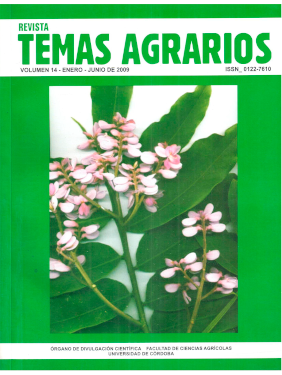AFLPS technique standarization for arrow cane (Gynerium sagittatum Aubl.) germplasm characterization
Estandarización de la técnica de AFLPS para la caracterización de germoplasma de caña flecha (Gynerium sagittatum Aubl.)

This work is licensed under a Creative Commons Attribution-NonCommercial 4.0 International License.
Show authors biography
The arrow cane (Gynerium sagittatum Aubl.) is the raw material used for typical craftsmanship in the Colombian Northen Coast. Knowing the genetic variability allows to design and develop breeding strategies and genetic plant resource conservation. The objective of the study was to develop an AFLPs protocol to evaluate the genetic variability among 25 arrow cane accessions planted at the Universidad de Córdoba collection. A total of 223 loci ranging from 43 (E-ACC/M-CAG) to 72 loci (E-ACA/M-CTA). Primer average loci was 55,75. Combination E-ACC/M-CAG generated the highest polymorphism (39,53%). Locus profiles were different for all individuals in the population indicating a good genome scrutiny for analyzing variability and genetic structure of the species.
Article visits 715 | PDF visits
Downloads
- Aramendiz, H.; Espitia, M. y Robles, J. 2005. Colección, caracterización morfoagronómica y producción de semilla de caña flecha (Gynerium sagittatum AUBL) del Caribe Colombiano. CIUC, Universidad de Córdoba, Montería, p52- 54.
- Ayanogulu, H.; Bayazit, S.; I"nan, G.; Bakir, M.; Akpinar, A.; Kazan, K. y Ergu 1, A. 2007. AFLP analysis of genetic diversity in Turkish green plum accessions (Prunus cerasifera L.) adapted to the Mediterranean region. Scientia Horticulturae 114:263-267.
- Balasaravanan, T.; Pius, P.; Raj Kumar, R.; Muraleedharan, N. y Shasany, A. 2003. Genetic diversity among south Indian tea germplasm (Camellia sinensis, C. assamica and C. assamica spp. lasiocalyx) using AFLP markers. Plant Science 165 365-372.
- Bassam, B.; Caetano Anolles, G. y Gresshoff, P. 1991. Fast and sensitive silver staining of DNA in polyacrylamide gels. Analytical Biochemistry 196(1): 80-83.
- Bentolila, S.; Hardy, T.; Guitton, C. y Freyssinet,G. 1992. Comparative genetic analyses of F2 plants and an ther culture derived plants of maize. Genome 35: 575-582.
- Benin, A.; Ehrich., D. y Manel, S. 2007. Statistical analysis of amplified fragment length polymorphism data: a toolbox for molecular ecologists and evolutionists. Molecular Ecology 16: 3737-3758.
- Chawla, H. 2002. MolecularMarkers and MAS. Introduction to Plant Biotechnology, Science Publishers, Plymouth, p329-358.
- Dice, L. 1945. Measures of the amount of ecological association betweem species. Ecology 26:297-302.
- Ferreira, M.; Satagopan, J.; Yandel, B.; William, P. y Osborn, T. 1995. Genetic mapping of loci controlling vernalization in rapeseed (Brassica napus L.) Theoretical and Applied Genetics 90: 727-732.
- Fregene, M.; Bernal, A.; Duque, M.; Dixon, A.; Tohme M. 2000. AFLP analysis of African cassava (Manihot esculenta Crantz) germplasm resistant to the cassava mosaic disease (CMD). Theoretical and Applied Genetics 100(5):678-685
- Karpa, K.; Bhat K.; Ayad, W. y Hodgkin, T. 1997. MolecularTools in Plant Genetic Resources Conservation: A Guide to the tecnologies. IPGRI Technical Bulletin No. 2. International Plant Genetic Resources Institute, Reme, p107-117.
- Lima, M.; Garcia, A.; Oliveira, S.; Matsuoka, H.; Arizono, C.; De Souza, J. y De Souza, A. 2002. Analysis of genetic similarity detected by AFLP and coeffcient of parentage among genotypes of cane Saccharum spp. Theoretical and Applied Genetics 104:30-38.
- Nei, M. y Li, W. 1979. Mathematical model for studying genetic variation in terms of restriction endonucleases. Proceedings of the National Academy of Sciences 76(10):5269-5273.
- Newbury, H. y Ford-Lloyd, B. 1993. The use of RAPD for assessing variation in plants. PlantGrowth Regulator 12:43-51
- Prashanth, S.; Parani, M.; Mohanty, B.; Talame, V.; Tuberosa, R. and Parida, A. 2002. Genetic diversity in cultivars and landraces of Oryza sativa subsp. indica as revealed by AFLP markers. Genome 45:451-459.
- Phillips, T.; Murphy, J. y Gooman, M. 1993. Isozyme variation in germplasm accessions of the wild oat Avena sterilis L. Theoretical and Applied Genetics 86:54-64.
- QIAGEN. 2004. QIAprep Spin Miniprep Kit.
- http://www1.qiagen.com/products/plasmid/qiaprepminiprepsystem/qiaprepspin miniprepkit.aspx. [Accedido: 08-12- 2008].
- Rohlf, F. (1998). NTSYS-PC, Numerical taxonomy and multivariate analysis system. Version
- 60. Aplied Biostatistics, New York.
- Selvi, A.; Nair, N.; Noyer, J.; Singh, N.; Balasundaram, N.; Bansal, K.; Koundal, K. and Mohapatra, T. 2005. Genomic constitution and genetic relationship among the tropical and subtropical Indian sugarcane cultivars revealed by AFLP. Crop Science 45: 1750-1757.
- Vos, P.; Hogers, R.; Bleeker, M.; Reijans, M.; Van De Lee, T.; Homes, M.; Frijters, A.; Pot, J.; Peleman, J.; Kuiper, M. y Zabeau, M. 1995. AFLP: a new technique for DNA fingerprinting. Nucleic Acids Research. 23:4407-4414.
- Young, N; Zamir, D; Tanksley, S. 1998. Use of isogenic lines and simultaneous probing to identify DNA markers tightly linked to the Tm-2a gene in tomate. Genetics 120:579- 585




















